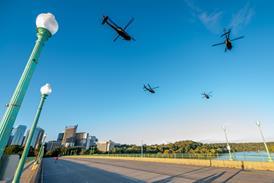Boeing is keen to offer a common cabin experience across its portfolio of aircraft - including the 777 - as the design language on its 787 twinjet proves immensely popular with customers.
The US airframer has already provided a level of "continuity and lineage and connection" between the 787 interior architecture and its new Boeing Sky Interior for the 737 narrowobody "while respecting that the airplanes perform different missions", said Pete Guard of Boeing Commercial Airplanes (BCA) cabin strategy.
"So a lot of the 787 design cues are appropriately scaled and honoured in the execution on the 737 from the entry way to the lighting to the overall look, feel and shape. A lot of interaction points are common, like the bin latches share a common lineage and look and feel. It's the sincerest form of flattery and we certainly want to have a place in the marketplace that says Boeing cabins are preferred and making sure that design consistency and design language are harmonized."
Boeing's new 747-8 widebody features some design elements of the 787. And an industry source tells Air Transport Intelligence and Flightglobal that the 777 is now being groomed for an upgrade.
Guard said: "I can't discuss where we are on other airplanes that we're studying now, but I think it would be safe to presume that you'll see features move across platforms so that we can perpetuate a common look and feel and common cabin experience."
The attributes that make the interior of the 787 twinjet so distinctive are well documented. A sweeping entryway greets passengers on boarding the aircraft. Super-sized luggage bins mean their baggage is expected to fit comfortably overhead.
Extra-large dimmable windows coupled with a unique LED lighting scheme - which simulates sunset and sunrise, and myriad other 'moods' - aim to inspire even weary economy-class passengers.
"If we look around today's airplanes, how people fly and how they experience flight, one thing we have observed is people want to look and view the outside, to the horizon to the earth. The magic of flight is very much associated with that. We felt that through the larger window we could help more people on the airplane be connected to that flying experience, not only the person adjacent to the window but people seated inward because the larger window allows that," said Guard.
He added: "Technology had advanced and we felt it was appropriate to make the jump. It was time to make a shift away from the mechanical shade to the dimmable window."
A decision on offering the dimmable windows on other types has not been taken, but Guard pointed out that "like in other transport sectors, features have a way of migrating across various platforms".
Source: Air Transport Intelligence news























